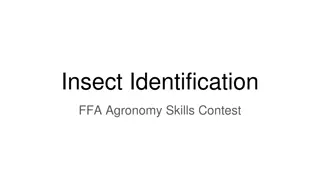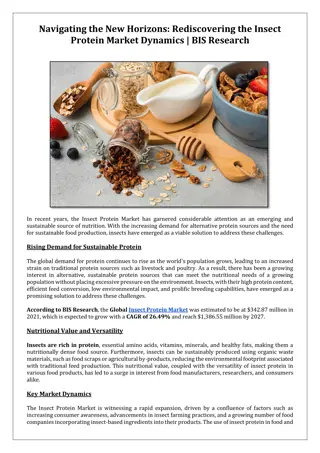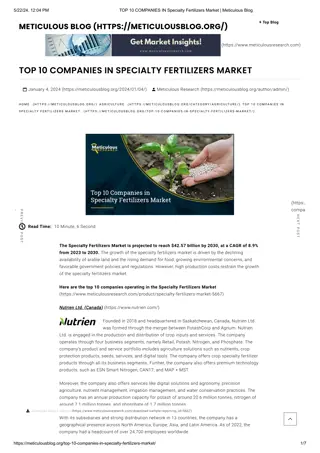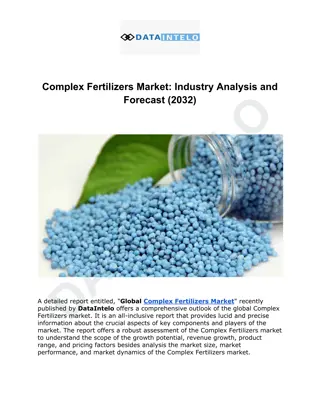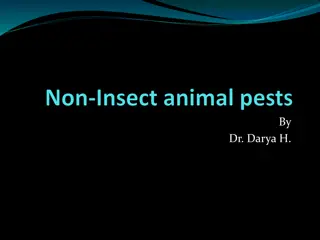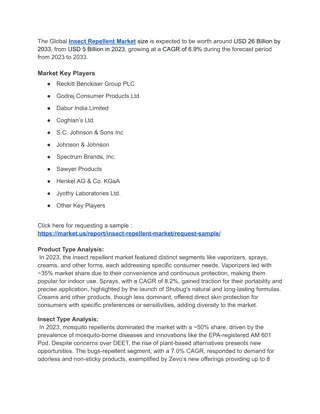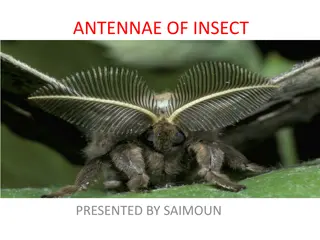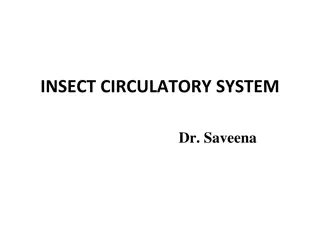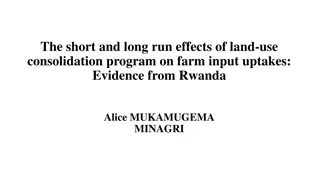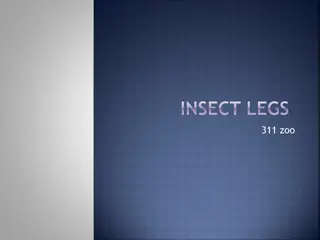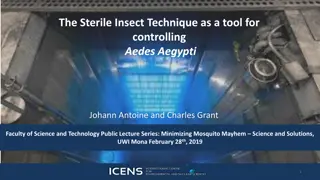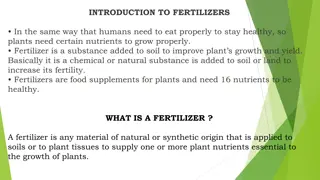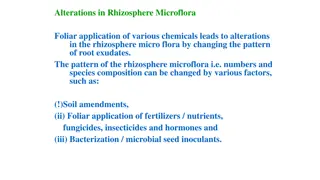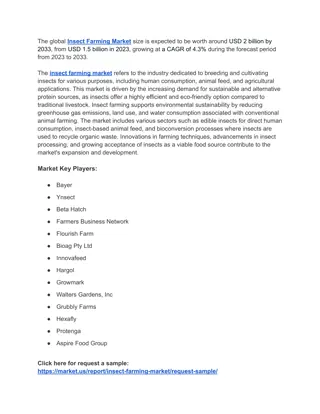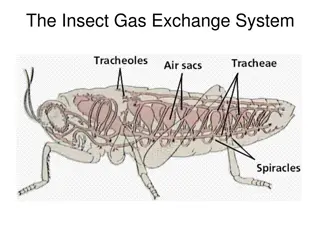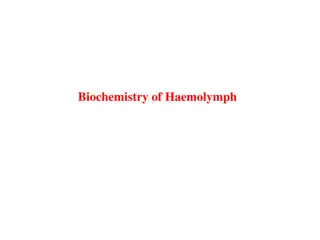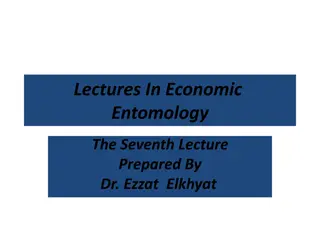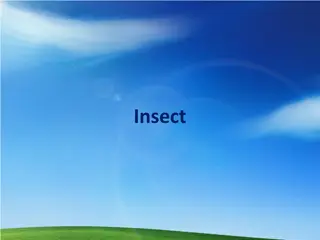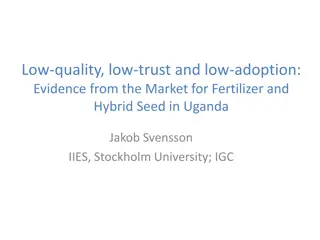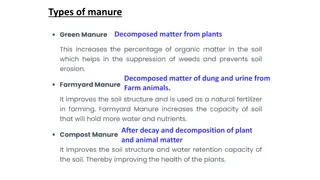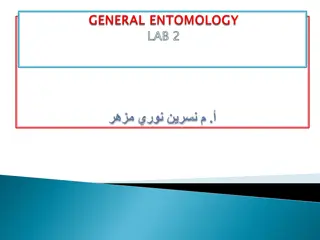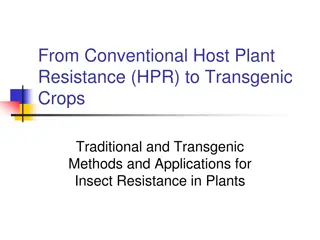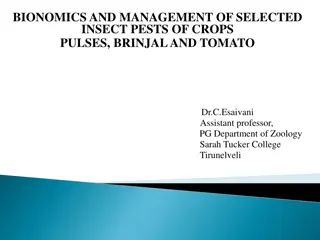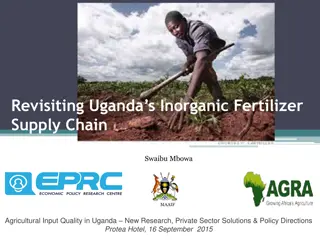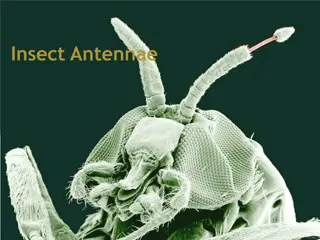Shumei Natural Agriculture: Improving Soil Health and Resilience
Shinya Imahashi practices Shumei Natural Agriculture to cultivate wholesome food without fertilizers or chemicals. Learn about continuous cropping and the impact on soil health, as well as the benefits of seed saving. Explore the Soil Health Index and microbial activities at Yatesbury Farm. Connect
42 views • 25 slides
Issues related to Fertilizers
Fertilizer supply plan for the Kharif season in 2023, including the promotion of alternate fertilizers, new initiatives, and expectations from states. It also provides data on the availability of fertilizers during Rabi 2022-23 and ongoing Kharif 2023.
9 views • 22 slides
Insect Abdominal Structures and Appendages: An Overview
The abdomen of insects plays crucial roles in respiration, reproduction, digestion, excretion, and metabolism. The number of abdominal segments varies across species, with reductions and modifications seen in different insect groups. From the propodeum to pregential and postgenital segments, each pa
1 views • 6 slides
Sustainable Rice Production in Pakistan: Challenges and Strategies
Pakistan's economy heavily relies on rice exports, with the country being a significant producer and exporter. However, challenges such as pesticide residues, major insect pests, and diseases threaten rice production. Key parameters for production include cultivation of improved varieties, pest mana
2 views • 42 slides
Issues related to Fertilizers
The Department of Fertilizers discussed key issues related to fertilizers at the Kharif Conference 2023, focusing on promoting alternate fertilizers like nano urea and nano DAP, as well as initiatives such as PM Kisan Samrudhi Kendras and One Nation One Fertilizer. Detailed figures were presented on
0 views • 22 slides
Understanding Biofertilizers: Production Technology and Types
Biofertilizers are natural microbial inoculants that provide nutrients to crop plants, improve soil health, and promote sustainable agriculture. Learn about the production technology, benefits, and types of biofertilizers including bacterial, fungal, algal, and aquatic fern biofertilizers. Explore h
5 views • 13 slides
Insect Identification for FFA Agronomy Skills Contest
Explore a variety of insects including the Alfalfa Weevil, Aphid, Army Worm, Assassin Bug, Bean Leaf Beetle, Black Cutworm, Chinch Bug, Colorado Potato Beetle, Common Stalk Borer, Corn Earworm, Corn Rootworm, Cricket, Cucumber Beetle, European Corn Borer, Flea Beetle, Grasshopper, Green Lacewing, Gr
1 views • 37 slides
Navigating the New Horizons: Rediscovering the Insect Protein Market Dynamics
According to BIS Research, the Global Insect Protein Market was estimated to be at $342.87 million in 2021, which is expected to grow with a CAGR of 26.49% and reach $1,386.55 million by 2027.
2 views • 2 slides
Insect Fertilizers Market Worth $319.7 Million by 2029
The fertilizers industry in Southeast Asia faced numerous challenges due to the COVID-19 pandemic, impacting the fertilizer distribution within and across markets in the Asia-Pacific region. Although lockdowns were imposed in Malaysia, fertilizer production facilities were given clearance to continu
5 views • 3 slides
Insect Protein Processing Equipment Market Worth $210.6 Million by 2029
The insect protein processing equipment market is driven by innovations in insect protein processing equipment, the increasing focus of insect protein manufacturers to reduce production costs, increased investments in the insect-based protein industry, and the rising demand for insect protein in the
0 views • 3 slides
TOP 10 COMPANIES IN SPECIALTY FERTILIZERS MARKET
The growth of the specialty fertilizers market is driven by the declining availability of arable land and the rising demand for food, growing environmental concerns, and favorable government policies and regulations. However, high production costs restrain the growth of the specialty fertilizers mar
0 views • 7 slides
Complex Fertilizers Market Industry Analysis and Forecast (2032)
The global complex fertilizers market size was USD 36.80 Billion in 2023 and is projected to reach USD 64.86 Billion by 2032, expanding at a CAGR of 6.50% during 2024\u20132032.
0 views • 4 slides
Understanding Non-Insect Pests in Agriculture
In this lecture, we delve into important non-insect pests affecting agriculture, such as nematodes, mites, snails, slugs, crabs, millipedes, birds, rodents, and more. Learn about their systematic positions, damages they cause, and characteristics. Explore the world of millipedes and centipedes, thei
0 views • 15 slides
Insect Repellent Market: Strategies for Success in a Competitive Market
The Global Insect Repellent Market size is expected to be worth around USD 26 Billion by 2033, from USD 5 Billion in 2023, growing at a CAGR of 6.9% during the forecast period from 2023 to 2033.\n\nClick here for requesting a sample : \/\/market.us\/
1 views • 3 slides
Insect Pests of Citrus: Identification, Behavior, and Management
Insect pests such as citrus butterfly, fruit-sucking moth, leaf miner, rust mite, and bark-eating caterpillar pose significant threats to citrus plants. These pests can damage citrus seedlings and various fruit varieties. Understanding their appearance, distribution, life cycle, and management techn
4 views • 14 slides
Understanding the Fascinating World of Insect Antennae
Insect antennae, also known as feelers, play a crucial role in sensory perception for insects. They help in detecting chemicals, perceiving various stimuli, and even aid in specialized functions like communication and prey-catching. The structure of antennae varies across insect species, showcasing
0 views • 11 slides
Insect Circulatory System: Overview and Functions
The insect circulatory system comprises an open type, where blood flows through the body cavity. Divided into three sinuses, it houses vital organs such as the heart and nerve cord. The dorsal vessel acts as the main organ of circulation, along with accessory pulsatile organs that supply blood to ap
0 views • 19 slides
Impact of Land-Use Consolidation Program on Farm Inputs in Rwanda
The study evaluates the effects of Rwanda's land-use consolidation program on farm input uptakes, specifically focusing on hybrid seeds, inorganic fertilizers, and pesticides. Results show significant increases in the adoption of hybrid seeds and inorganic fertilizers among participating households
0 views • 10 slides
Understanding Insect Legs: Anatomy and Adaptations
Explore the intricate anatomy of insect legs, comprising segments like coxa, trochanter, femur, tibia, and tarsus, each serving specific functions for locomotion. Discover how these legs are adapted for diverse tasks like walking and running in different insect species.
0 views • 18 slides
Utilizing Sterile Insect Technique for Aedes Aegypti Control
The Sterile Insect Technique (SIT) is a biologically-based method used to manage key insect pests by releasing sterile insects to decrease population reproduction. This technique, developed through genetic manipulation and ionizing radiation, has been instrumental in controlling insect populations l
0 views • 13 slides
Understanding Fertilizers and Their Types
Fertilizers are essential for plant growth, providing nutrients necessary for healthy development. They are classified into organic and inorganic types, each with its own advantages and disadvantages. Organic fertilizers, sourced from natural materials like plants and animals, enrich the soil with o
2 views • 7 slides
Understanding Alterations in Rhizosphere Microflora Due to Chemical Applications
Chemical applications through soil amendments, foliar fertilizers, and microbial seed inoculants can lead to changes in the rhizosphere microflora composition. Factors like soil amendments with fertilizers, foliar application of chemicals, and seed treatment with bio inoculants play a role in alteri
5 views • 24 slides
Insect Farming Market
The global Insect Farming Market size is expected to be worth around USD 2 billion by 2033, from USD 1.5 billion in 2023, growing at a CAGR of 4.3% during the forecast period from 2023 to 2033.\nClick here for request a sample: \/\/market.us\/report\
1 views • 4 slides
Global Insect Pest Control
The Global Insect Pest Control Market is anticipated to reach USD 20.43 billion by 2032, at a CAGR of 4.6% over the predicted period from 2022 to 2032.
1 views • 4 slides
Understanding the Insect Gas Exchange System
The insect gas exchange system involves spiracles, tracheae, and tracheoles that facilitate the exchange of gases to support respiration in insects. Spiracles lined with chitin control airflow, while tracheae and tracheoles enable oxygen to dissolve into the haemolymph through passive diffusion, sup
0 views • 18 slides
Understanding the Biochemistry of Insect Hemolymph
Insect hemolymph, also known as blood, plays a crucial role in maintaining the tissues throughout the body. It consists of plasma containing hemocytes suspended in a fluid rich in various chemicals. The pH of the hemolymph ranges between 6.4 and 6.8, with variations in volume across different insect
0 views • 9 slides
Embracing Insect-Based Diets for a Sustainable Future
Emphasizing the urgency of meeting the growing protein demand sustainably, the article explores the benefits of entomophagy - consuming insects as food. Experts advocate for insect-based diets to address environmental concerns, citing insects as a rich protein source with lower greenhouse gas emissi
0 views • 6 slides
Understanding Economic Entomology: A Focus on Pest Management in Horticultural Plants
Explore the world of economic entomology and delve into the study of insects that either benefit or harm humans and their products. Learn about the general definitions of pests, taxonomy of pests, and why insect pests are considered the most important group of pests. Discover the impact of insect pe
0 views • 24 slides
Understanding Insect Life Cycles and Management Strategies
Exploring the world of insects, this content delves into the life cycles and damage caused by key insect pest groups, emphasizing the importance of knowing their life stages for effective pest management. It covers insect development, how insects cause injury, pest control principles, threshold leve
0 views • 20 slides
Addressing Low Adoption of Modern Agricultural Technologies in Uganda
Market failures are hindering the adoption of high-yielding seed varieties and fertilizers by smallholder farmers in Uganda. Research suggests various constraints such as lack of information, credit, and insurance. A hypothesis is proposed, questioning if the technologies are not adopted due to adul
0 views • 35 slides
A Comprehensive Guide to Fertilizers and Manure for Agriculture
Explore the various types of manure, nutrients in fertilizers, organic and inorganic fertilizers, biofertilizers, pond fertilization techniques, and factors influencing proper pond fertilization. Learn about different types of fertilizers used for pond fertilization, including solid fertilizers. Enh
0 views • 17 slides
The Anatomy of an Insect Head: A Detailed Look
Explore the intricate structures of an insect head, including the segmentation, sclerites, sutures, and specialized features like the occiput and ocular sclerites. Discover the unique characteristics that define the head capsule in insects through frontal, lateral, dorsal, and posterior views, shedd
0 views • 10 slides
Agriculture and Fertilizer Business Insights in Uganda
Balton Uganda Limited, a subsidiary of Balton CP Group, operates in various Sub Saharan countries including Uganda. The company's departments cover Agriculture, Communication, Public Health, and more. The focus on Fertilizer Business in Uganda includes trends from 2011-2013, distribution channels, m
0 views • 19 slides
Evolution of Plant Resistance to Insects: From Traditional Methods to Transgenic Crops
The transition from Conventional Host Plant Resistance (HPR) to Transgenic Crops for insect resistance in plants has a rich history dating back to the 1790s. Traditional methods like breeding for Hessian fly resistance in wheat have paved the way for modern techniques. Factors influencing insect res
0 views • 36 slides
Bionomics and Management of Insect Pests in Crops: Insights and Strategies
Explore the bionomics and management practices for key insect pests affecting crops like pulses, brinjal, and tomato. Learn about the life cycles, damage caused, and effective control measures for pests such as the greasy cutworm and plume moth.
0 views • 30 slides
Analysis of Inorganic Fertilizer Supply Chain in Uganda
Examining the accessibility and quality of inorganic fertilizers in Uganda, the study focuses on key regions, targeted fertilizers, methodology, findings on moisture content and weight compliance, and implications for farmers. The research sheds light on challenges and opportunities in the country's
0 views • 17 slides
Understanding the Phosphorus Cycle and Its Impact on Ecosystems
Humans use phosphorus in various ways, from being a vital component in DNA, RNA, and cell membranes to its role in energy transfer processes. The phosphorus cycle involves steps such as weathering of rocks, phosphate mining for fertilizers, excretion/decomposition, and geologic forces. However, exce
0 views • 8 slides
Insights into the Career Journey of Jarrod Leland at Novozymes
Jarrod Leland, a Ph.D. holder in Entomology from VT, transitioned from being a Government Scientist to a Scientist at Novozymes focusing on insect pathogens. With vast experience in the field, he now leads a team of 20 individuals, emphasizing the use of insect pathogens as alternatives to chemical
0 views • 17 slides
Exploring the Fascinating World of Insect Antennae
Insect antennae serve as vital sensory organs for these creatures, offering more than just a sense of touch. They play key roles in detecting odors, changes in humidity, sounds, and air speed. This article delves into the diverse types of insect antennae, showcasing their unique structures and funct
0 views • 19 slides
Insect Management Update for Corn, Sorghum, and Sugarcane Aphids
Explore the latest updates on insect management for corn, sorghum, and the impact of sugarcane aphids. Learn about potential yield loss, thresholds for management, best insecticides, current issues in corn, and strategies for effective pest control. Stay informed to protect your crops and optimize p
0 views • 33 slides






